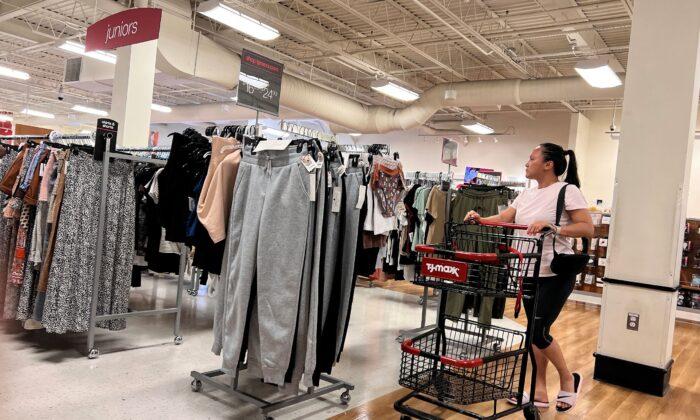NEW YORK—Inflation-weary U.S. shoppers have been skimping on clothing purchases, prompting retailers to slash prices to clear inventory off the racks.
Gap was the latest retailer to report a slump in apparel shopping for the second-quarter, saying on Thursday that net sales slumped 8 percent from a year earlier to $3.86 billion. Earlier this month, executives at U.S. giants Walmart and Target offered deep discounts and rollbacks on clothing.
Gap is “taking actions to sequentially reduce inventory, rebalance our assortments to better meet changing consumer needs,” Katrina O’Connell, Gap Inc. chief financial officer, said in a statement.
Deep discounts on apparel, especially at Old Navy, hurt the company’s margins. Old Navy stores were not able to sell certain sizes and styles, while Gap struggled with mix imbalances for items including “mid-tops and casual shorts,” O'Connell said.
Shoppers may see more promotions as the company keeps clearing inventory. In a Thursday earnings, O'Connell said she expects inventory levels in the third-quarter to be similar to Q2, with improvements in the fourth-quarter.
Sales at U.S. apparel and accessory retailers have largely flatlined. Over the 12-months through July they averaged month-over-month growth of just 0.2 percent, according to Census Bureau data.
At Hollister, the lower-priced line at Abercrombie and Fitch, sales declined 15 percent in the second-quarter compared to last year, the company said on Thursday, with trends moving away from pants styles and core categories. Abercrombie sales were up 5 percent.
“Assuming recent trends remain consistent, we expect to continue to leverage markdowns in Q3 to keep seasonal items turning,” Abercrombie & Fitch CEO Fran Horowitz, said in a Thursday call to investors.
This week, Victoria’s Secret, Urban Outfitters, and Kohl’s told analysts in conference calls that shoppers are only buying certain types of garments. The companies gave no specific examples but a search of the Victoria’s Secret website showed Victoria’s Secret shoppers buying bras on sale at two-for-$52, while its PINK line for younger shoppers appeared to have trouble moving a $52.95 pair of joggers.
Urban Outfitters and Victoria’s Secret said sales are declining for brands tailored to younger consumers. Victoria’s Secret’s PINK line saw strained clothing sales compared to the company’s Victoria brand of intimates and sleepwear.
“We will be very prudent on our purchases” of apparel “for the back half of the year,” Victoria’s Secret Chief Executive Martin Waters said during the company’s earnings call Thursday.
Urban Outfitters’s young, less-affluent shoppers held off from purchasing full-priced items and waited “for promotions before buying,” Urban’s CEO Richard Hayne said on Tuesday.
Kohl’s said sales slipped for junior’s apparel in the second quarter because designs were “too much fashion, not enough of the basics.” Women’s apparel outperformed other categories.
“Some of the fashion choices were a little too young, I would say. That’s been course-corrected,” Kohl’s CEO Michelle Gass said on a Tuesday earnings call. “I'd say one of the things that has hurt us is with all (the) supply chain disruption that’s happened, we were not able to get in and out of some of those items.”
Walmart and Target both struggled to sell apparel that arrived a few seasons late, and are aggressively cutting prices. Target said last week that one bright spot was “meaningful growth” in sales of trendy women’s clothing.
Jessica Ramírez, senior research analyst at Jane Hali and Associates, said she has noticed heavy discounts on Gap and Old Navy labels, while the higher-end Banana Republic brand, which sells dressy office-wear, has sold more garments at regular prices.
Macy’s and Kohl’s said demand was solid for dressy-looks and work-ready clothing. Kohl’s said women’s and men’s “elevated casual” styles outperformed as more people returned to work. It has been investing in dressy styles from brands including Simply Vera, Lauren Conrad, and Nine West, for customers who are working in offices more often. Still, it is planning clearance events to move unwanted items.
Macy’s CEO Jeffrey Gennette said on the company’s earnings call on Tuesday that occasion-based clothing in men’s and women’s are “very healthy categories” with men’s work clothing average selling prices increasing 29 percent and “missy career” items up 20 percent. Other categories have required heavy promotions to unload excess inventory.





